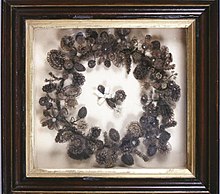
KNOWPIA
WELCOME TO KNOWPIA
Summary
A lock of hair is a piece or pieces of human hair that are usually bunched or tied together in some way. A lock of hair can be on a person's head, or have been cut from the head. When attached to the head, a lock of hair generally refers to a tress, curl, or ringlet of hair.[1] When cut from the head, a lock of hair may be kept for its symbolic value.

Symbolic value edit
Locks of hair often carry symbolic value and have been utilized throughout history in various religious, superstitious, sentimental and romantic contexts. Examples include:
- A traditional belief maintains that owning a lock of hair from an individual's head gives a person magical power over that individual.
- Historically, giving a lock of one's hair to someone has been considered a sign of love and devotion, especially before an impending parting. It is still a popular trope in fiction, particularly the romance genre. Such locks are intended to be kept by the recipient as a memento.
- During antiquity, Roman girls who were about to be married offered locks of hair to Jove (Jupiter) in his forest god aspect, Virbius (Virbio).
- A common superstition holds that a lock of hair from a baby's first haircut should be kept for good luck.
- An old Irish superstition holds that it is unlucky to accept a lock of hair (or a four-footed beast) from a lover.
- In Victorian times it was common for bereaved family members to keep locks of hair from deceased children or family members. These locks of hair were seen as mementos and served to comfort the surviving loved ones. These locks of hair were typically kept in lockets. Small jars, and other kinds of jewellery including bracelets, earrings, and brooches (see hair jewelry) were also used.
Use In hairstyles edit
The following hairstyles make use of lock(s) for symbolic or aesthetic reasons.
- Childhood lock:
- An ancient and worldwide (e.g. China, Egypt, Thailand, Albania, Ukraine, India, Israel, etc.) pre-adolescent custom was to shave children's heads, leaving one lock (or sometimes several isolated locks) untouched. Upon reaching adulthood, the lock of hair was usually cut off (see Rites of passage).
- Scalp lock:
- The scalp lock describes a hairstyle consisting of a single long lock of hair on an otherwise shaven head. Like childhood locks, the scalp lock was a worldwide phenomenon, particularly noted amongst eastern woodland Native American tribes (see Iroquois, Huron, Mahican, Mohawk) in North America (see also Scalping and Mohawk hairstyle).
- According to Leo the Deacon, a Byzantine historian, Sviatoslav I of Kiev was reported to have worn a scalp lock. Later Ukrainian Cossacks (Zaporozhians) sported scalplocks called oseledets or khokhol.
- The Imazighen (Berber) men of Morocco had the custom of shaving the head but leaving a single lock of hair on either the crown, left, or right side of the head, so that the angel Azrael is able "...to pull them up to heaven of the Last Day."[2] This hairstyle is observed by Mark Twain in his travel book The Innocents Abroad, in which he describes Moroccan men as sporting scalplocks.[3]
- Polish plait:
- A Polish plait (Koltun in Polish, meaning "Knot", but often referred to in English as an "Elf-Lock") is a lock of matted hair similar to a dreadlock. Due to a scalp disease (Plica polonica), King Christian IV of Denmark (1577–1648) had a Polish plait hanging from the left side of his head, which in an engraved portrait in the Royal Collection is adorned by a large pearl. His courtiers were said to have adopted the hairstyle in order to flatter the king.[4] Due to superstitious beliefs, the Polish plait used to be particularly common in Poland (hence its name). Initially, the plait was treated as an amulet, supposed to bring good health, as the plait was supposed to take the illness "out" of the body, and therefore it was rarely cut off.
- Lovelock:
Notable Examples edit
The following locks of hair are notable for their cultural or historical significance:
- A lock of Beethoven's hair, cut from his head in 1827, was auctioned in 1994 through Sotheby's of London.[6] Research on the hair determined that the composer's lifelong illness was caused by lead poisoning.
See also edit
Look up Curl in Wiktionary, the free dictionary.
- Ringlet (haircut)
- Dreadlocks, commonly called locs or dreads.
- Goldilocks, a nursery rhyme character so named due to her golden hair
- Payot, sidelocks, or earlocks worn by male Orthodox Jews
Notes edit
- ^ Dictionary.com Unabridged. "the definition of lock". Dictionary.com. Retrieved 2017-06-17.
- ^ El Maghreg: 1200 Miles' Ride Through Morocco, Hugh Edward Millington Stutfield
- ^ The Innocents Abroad, or The New Pilgrims' Progress, Mark Twain, 1869
- ^ "RCIN 612170 - Christianvs Qvartvs dei Gratia Daniae, Norwegiae". Royal Collection. Retrieved 1 November 2017.
- ^ Hall, James. The sinister side: how left-right symbolism shaped Western art. p. 278.
- ^ "Lock of hair makes its way through history". Jewish News of Greater Phoenix. Archived from the original on 10 June 2012.
Sources edit
- The Golden Bough by James Frazer - Penguin Books, ISBN 978-0-14-018931-5
- The Innocents Abroad by Mark Twain - Signet Classic, ISBN 1-85532-848-8
- Armies of Medieval Russia 750-1250 by David Nicolle - Osprey Publishing, ISBN 0-451-52502-7
- Daily Life in Ancient India From 200 BC to 700 AD by Jeannine Auboyer - Phoenix Press, ISBN 1-84212-591-5
- The Cossacks by John Ure - The Overlook Press, ISBN 1-58567-138-X
- (in English) Ancient Egyptian Hairstyles
- (in English) Ukrainian Cossack Display Group
- (in English) Common Superstitions
- (in English) Ancient Legends, Mystic Charms, and Superstitions of Ireland


